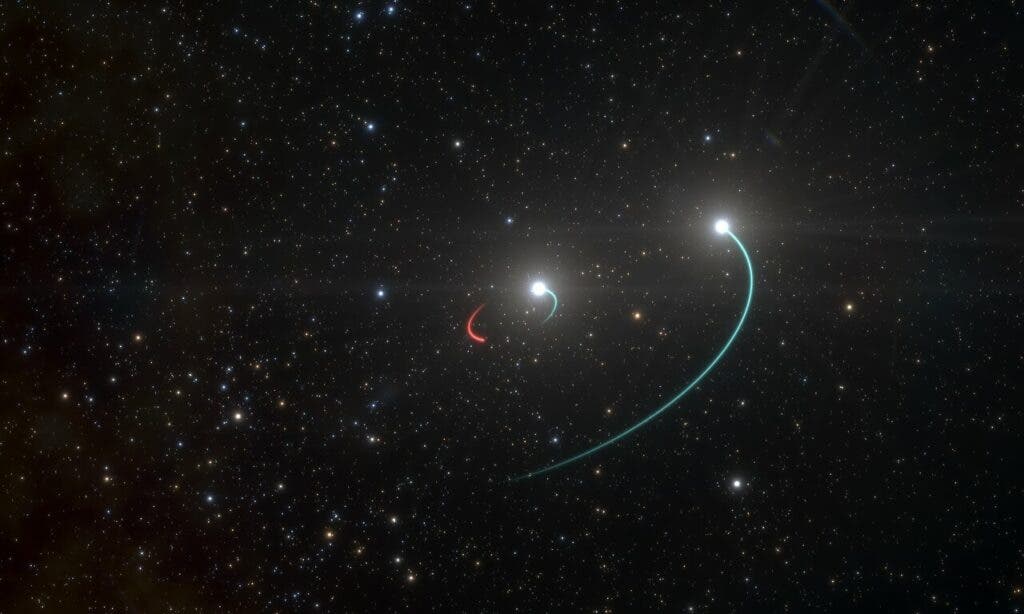
Researchers affiliated with the European Southern Observatory (ESO) have detected an invisible object orbiting a double-star system. Upon closer inspection, the object was revealed to be a black hole. Lying just 1,000 light-years away from Earth, this makes it the closest black hole found thus far. In fact, the stellar system that the black hole calls home can be seen with the naked eye.
The first stellar system with a black hole that can be seen with the unaided eye
Originally, the astronomers were observing HR 6819 as part of a study of double-star systems. However, after many months of observations, the researchers noticed that one of the two visible stars orbits an invisible object every 40 days, while the second star is at a relatively large distance from this object. This invisible object turned out to be a black hole, making HR 6819 a triple system.
The observation was performed using the FEROS spectrograph on the MPG/ESO 2.2-metre telescope at the La Silla Observatory in Chile.
“The dullest object one can imagine”
“Because it is not being “fed” by its companion star, it does nothing, except for orbiting its companion star. It is the dullest object one can imagine, just the dead remains of a once-powerful star. However, that is exactly what makes this boring individual exciting because there should be many more awaiting their discovery,” Dietrich Baade, Emeritus Astronomer at ESO in Garching and co-author of the study, told ZME Science.
But this is just the tip of the iceberg. The astronomers believe that silent black holes are actually extremely abundant in the universe. Already, the researchers believe that their findings apply to another system, called LB-1, which may also be a triple system.
“Perhaps, the biggest challenge was to keep going with the observations and their analysis until our friend Stan Štefl could determine the orbital period of 40 days. We are still sad that he died in a car accident in 2014 and cannot receive his share in the recognition of our work. Already in 2010, he laid the foundation to the ‘Aha!’ we experienced at the end of 2019 when we realized that the then newly published observations of the system LB-1 were hard to distinguish from ours of HR 6819. This prompted us to resume our work on HR 6819 which confirmed the conclusion reached back in 2010 that this system consists of 2 luminous stars and one invisible object. LB-1 has the same architecture (contrary to the discovery announcement, which portrayed LB-1 as a binary star). Our more in-depth analysis now demonstrates clearly the black-hole nature of the unseen object in HR 6819,” Baade said.
Unlike most black holes identified thus far, the one lurking in the HR 6819 system does not interact too much with its environment. Since it doesn’t engulf a lot of matter and energy, it doesn’t draw attention, appearing truly ‘black, which added to the challenge of discovery.
“Not only did we find one of the first 2 or 3 black holes (BHs; perhaps even the very first one) that do not shine brightly in X-rays (because they are not fed with gas from a luminous companion star) but it is also the most nearby of all types of BHs. The latter implies that such BHs must be very common because the solar system is not at a place with special properties,” Baade told ZME Science.
Baade and colleagues believe that there may be many more black holes that are just as inconspicuous as the one lurking in the HR 6819 system.
Previous work that modeled stellar populations suggests that there should be 100 million to one billion stellar-sized black holes in the Milky Way. However, no more than two dozen black holes have been found thus far in our galaxy.
The astronomers believe that this low black hole count is due to the fact that most of them likely do not emit bright X-ray light. There may be hundreds of millions of X-ray-quiet black holes silently populating the Milky Way, according to Baade.
“Since isolated BHs are next to impossible to detect in significant numbers, multiple stars in which at least one of the luminous stars is forced into an orbit about the BH, are the best way forward towards filling in the giant gap between observations and models,” he added.
In addition to offering clues about the behavior of X-ray-quiet black holes, the findings might also explain the occurrence of certain cosmic mergers that trigger gravitational waves powerful enough to be detected from Earth. Distant outer objects, such as the distant star in the HR 6819 triple system, can gravitationally influence the merge of the inner pair (innermost star and black hole), astronomers suggest.
“We shall try to obtain more observations to find and characterize more systems so that their commonalities can identify the patterns of their formation and evolution. In addition, we shall investigate published reports about other systems for possible alternative interpretations (cf. LB-1). In this way, our work will contribute to further complementing our understanding of the evolution of single stars, multiple stars, and the Milky Way. This also includes the history and the future of our Sun and the solar system,” Baade concluded.
The findings appeared today in the journal Astronomy & Astrophysics.






